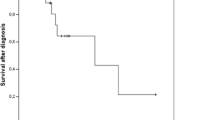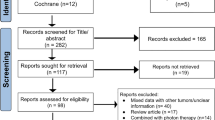Summary
Objective. To analyze a series of patients with pathologically confirmed skull-base chordoma, and to develop an algorithm for the management of this challenging disease based on the data, our experience, and the current literature.
Material and methods. Between the years 1986 and 2001, 26 chordoma patients received multimodality treatment with various combinations of conventional surgery, skull-base surgical techniques, and gamma-knife surgery at the Marmara University Faculty of Medicine. A total of 57 procedures (43 tumor excision surgeries, 7 gamma-knife procedures, and 7 other operations to treat complications) were performed. The mean follow-up period was 4 years (48.5 months). Karnofsky scoring was used to follow the patients’ clinical conditions, and magnetic resonance image analysis was used to measure tumor volume over time.
Results. Seven patients died during follow-up. Two of the deaths were due to surgical complications, four resulted from clinical deterioration related to tumor recurrence, and one was unrelated to neoplasia. The rate of tumor recurrence after the first surgical treatment was 58%. Residual tumor volume was lower in the cases in whom skull-base approaches were used as first-line management. The 19 survivors showed little change in clinical status from initial diagnosis to the most recent follow-up check. The mean follow-up time after gamma-knife treatment was 23.3 months. During this period, mean tumor volume increased 28% above the mean volume at the time of gamma-knife surgery. The mean Karnofsky score decreased by 6% during the same time frame.
Conclusions. The most effective first-line treatment for chordoma patients is surgery. The findings for residual tumor volume indicated that skull-base approaches are the best surgical option, and the complication rates for these techniques are acceptable. However, it is rare that surgery ever biologically eradicates this disease, and the data showed that these chordomas almost always progress if the tumor volume at the time of diagnosis exceeds 20 cm3. Based on our experience and the biological character of the disease, we now advocate radiosurgical treatment (gamma-knife in our case) immediately after the first-line skull-base surgery when the tumor residual volume is <30 cm3.
Similar content being viewed by others
Author information
Authors and Affiliations
Rights and permissions
About this article
Cite this article
Pamir, M., Kılıç, T., Türe, U. et al. Multimodality management of 26 skull-base chordomas with 4-year mean follow-up: experience at a single institution. Acta Neurochir 146, 343–354 (2004). https://doi.org/10.1007/s00701-004-0218-3
Published:
Issue Date:
DOI: https://doi.org/10.1007/s00701-004-0218-3




